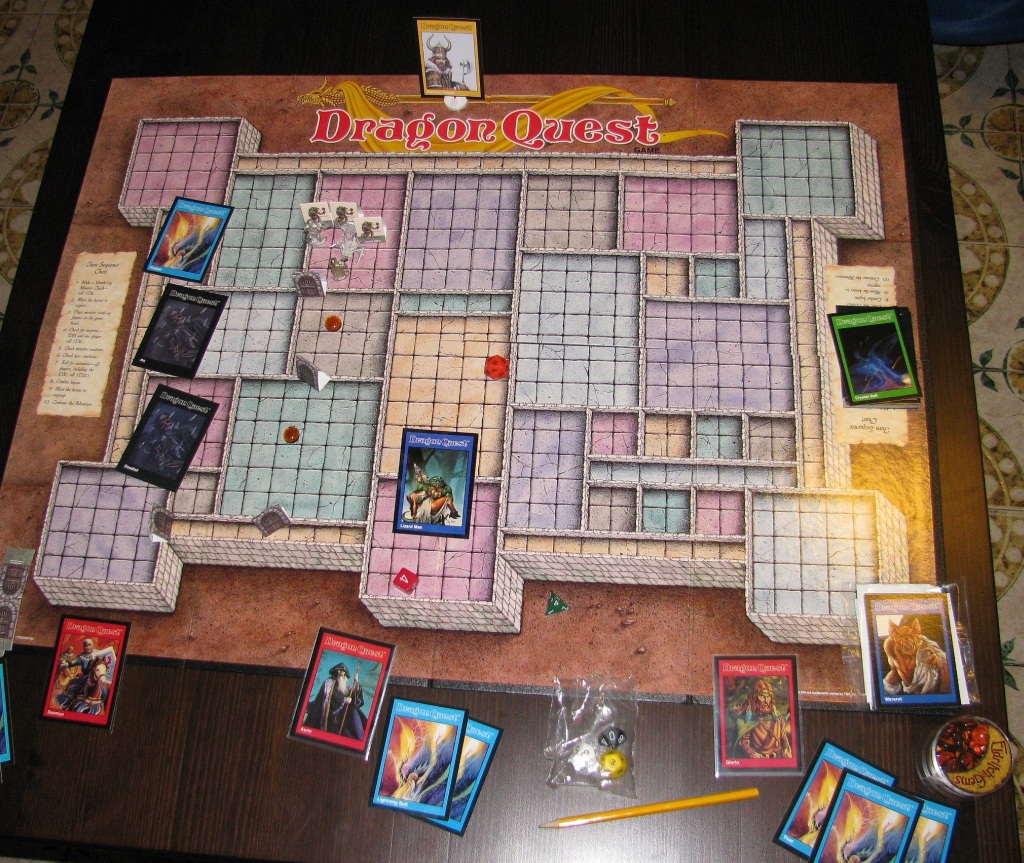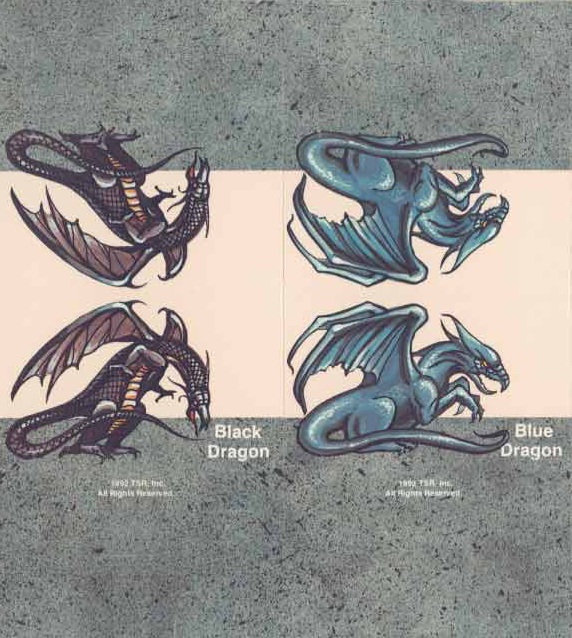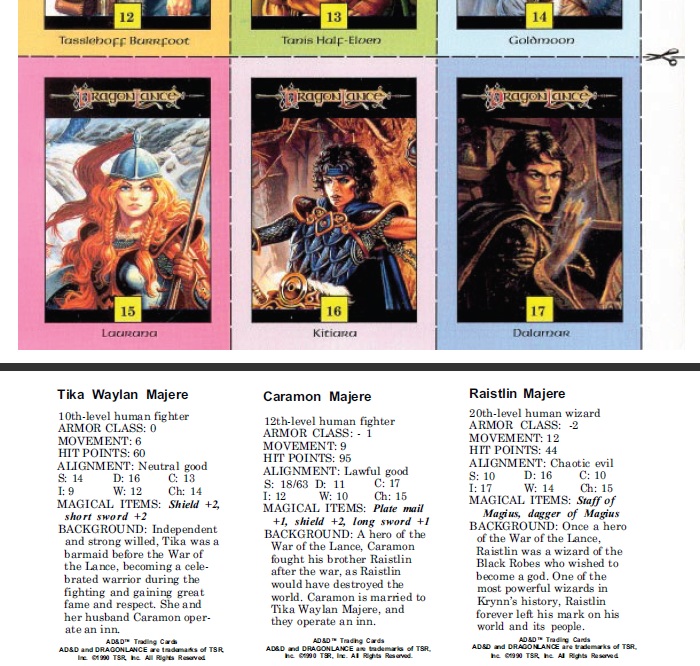Playing DragonQuest Solo
|
This post was updated on .
I love Dragon Quest and I created a variant to play solo or, in any case, without a DM.
Please tell me what you think posting in BGG. Tonight I'm gonna play it with a friend. http://www.boardgamegeek.com/article/5143015#5143015 I also use the rules with other D&D modules of that period (Black box series) with another variant. |
Re: TSR's DragonQuest Adventure Game
|
Administrator
|
Good stuff, looks like it runs smoothly and doesn't slow down the pace of the game. Reminds me a lot of how the 'Maze Level' (Using the HQ board) works in Advanced HeroQuest. I may give them a try next time I get my DQ box out
 nice to see demonstration pictures of the rules being used too  With a little adaptation your 'BUILD A DUNGEON' rules could be used to play Dragon Quest on other dungeon floor-plans such as the HQ board, the WHQ tiles or Billiam Babble's Ink Adventure floor-plans, giving scope for all kinds of dungeon layouts cool I'm interested in doing something very similar, do you have this variant written up anywhere? PS Finally (in my capacity as the co-founder of this site) I'd like to discourage you from asking that people post elsewhere as we are trying to 'grow' The Lost and the Damned Forum and every member's posts counts toward our community 
-----------------------------------
~The ravings of a single mad Goblin is bad enough, but such a power-hungry, malice-filled creature as Mortis can never hope to be understood~ |
|
This post was updated on .
Well, in TSR colored maps like the one in the Black box (I own almost the entire Thunder Rift series) you cannot ignore the rooms creating a different path due to the particular nature of the map, revealed with objects and open doors. So I assume that the entire area is explorable.
I roll for wandering monsters in corridors/rooms NOT numbered; in numbered rooms I roll a D6 assuming that 4-5-6 means an encounter. To know the type of the encounter I roll the usual d4 (1=object/trap "=1 monster etc... like explained in my variant). To select the monster I sort a monster card, like I explained.  Someetimes I want to play an adventure strictly connected with the module map (reading at loud voice room description, etc.): I put only the monster cards described in the module eventually re-using them if finished (adding some custom card if necessary) and I prepare the big boss statistics (for example, Zanzer the magician). Two dangers are: -sorting the boss in the first rooms -not sorting it at all, due to the sorting method To avoid these problems I could prepare a special pile of cards equal to the number of the rooms (for ex. 15); a pile randomly generated with for example five blank cards (=nothing happens), five monster cards, one boss card and four trap/object card, putting the boss card in the last three positions and mixing them (like in D&D Castle Ravenloft). When I sort a monster card I could roll a d4 to determine the number. If there aren't enough paper stands, I assume that the extra monsters are represented by lizard men or by the most common monster in that module. |
Re: TSR's DragonQuest Adventure Game
|
In reply to this post by aka-rabat
Solo gaming? *is most intrigued*
I may have to check this out. |
Re: TSR's DragonQuest Adventure Game
|
Administrator
|
In reply to this post by aka-rabat
Do you have a particular method for converting the D&D monster's/NPC's rules to work with DragonQuest? or do you simply rely on the systems being similar enough to work with each others rules? Good system, simple but effective - Warhammer Quest uses a similar method to make sure the Objective Room comes at the end of the adventure so you've played the new Castle Ravenloft game?
-----------------------------------
~The ravings of a single mad Goblin is bad enough, but such a power-hungry, malice-filled creature as Mortis can never hope to be understood~ |
|
I’ve also read Castle Ravenloft rules to write my DQ variant, and I think that DQ has more monsters, items, graphics, and more variety. It is also expandable with Thunder Rift modules and TSR big boxes…. (I’ve also bought a shrinkwrapped copy of Dragon’s Den).
The following is an example of text taken by TSR “Assault on Raven’s ruin” (Thunder Rift series). As you can easily imagine the whole text can be read, two goblin and two wolf figures will be used and put in the middle of the room, or wherever are put by the module. Use DQ rules complete with variant. The behavior of the monsters is described in my variant rule. For monsters stats use Dragon Quest cards or consider for every new monster contained in the module its own AC, HP, THACO (= fighting score in DQ), movement rate (TSR says that 10 feet are equal to one square) and Damage with the right dice (1d6). For a new monster you can simply write the stats on a DQ blank card. Naturally you will not meet Raven in his own room, but randomly in one of the rooms of the map. In any case you can choose to put him in the room dedicated by the module. If you lack the paper figure of a new monster use a similar one from DQ. For NPC prepare another blank card to sort knowing that if the character is evil it will attack, if is is good or neutral it will help heroes. Here are new printable double-sized stands from other modules... TSR 9363:  " (...) Raven’s Ruin Room 7: Dining room (BOXED TEXT) This large room was once a formal dining room. A large table surrounded by chairs sits in the center of the room, and a cabinet full of dishes sits in a corner. As you look around the room, you hear a low growl. As a pair of wolves comes around the end of the table, two goblins climb up and onto it. They do not look happy to see you. END OF BT Raven’s notes: The formal dining room is done, with room for a dozen people to dine. I let myself be a bit mischievous and included a trap with one of the doors. Hopefully, I will remember not to use that door myself. Oh yes, the silverware drawer is also trapped, with a poisoned needle. These goblins recently returned from a raid and have been counting their loot, hoping to hide away some choice items before giving the rest to their hobgoblin leaders. They will command the wolves to attack and will fight to the death to defend their loot. Goblins (2): AC 6; HD 1-1; hp 4 each; MV 90‘ (30’); #AT 1; THACO 19; Dmg ld6 (short sword); Save as Normal Man; ML 7; AL C; XP 5; Treasure see below. Wolves (2): AC 7; HD 2 +2; hp 10 each; MV 180’ (60’); #AT 1; THACO 17; Dmg ld6; Save as Fighter: 1; ML 6; AL N; XP 25; Treasure Nil. (...) In Thunder Rift modules is explained how to play D&D without a DM: simply read the boxed text whenever a player enters a room, then each player decides what to do. Once decisions are made, read the remaining text of the room. Rage of the Rakasta module (playable also as solo) precises that it can be used also “with the Dragon Quest game” with little adaptations. I also create new characters using these cards and modifying the stats (Dragon Magazine 180 Free trading cards): 
|
«
Return to Other D&D and TSR games
|
1 view|%1 views
| Free forum by Nabble | Edit this page |

